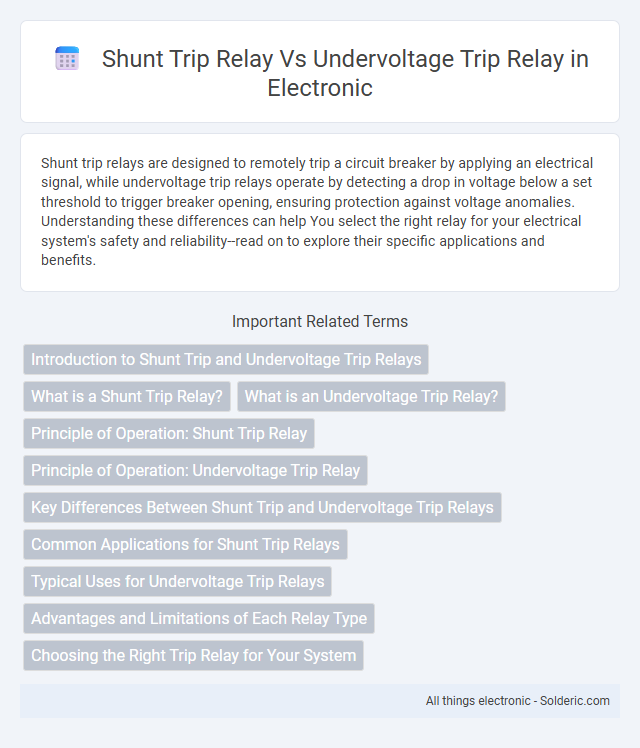Shunt trip relays are designed to remotely trip a circuit breaker by applying an electrical signal, while undervoltage trip relays operate by detecting a drop in voltage below a set threshold to trigger breaker opening, ensuring protection against voltage anomalies. Understanding these differences can help You select the right relay for your electrical system's safety and reliability--read on to explore their specific applications and benefits.
Comparison Table
| Feature | Shunt Trip Relay | Undervoltage Trip Relay |
|---|---|---|
| Function | Trips circuit breaker remotely via an external signal | Trips circuit breaker when voltage drops below a set threshold |
| Operation Type | Electrically energized coil activates trip | Voltage-dependent coil trips upon undervoltage condition |
| Use Case | Emergency stop, remote shutdown, external control | Protection against undervoltage, phase loss, or power failure |
| Control Signal | External DC or AC signal to energize coil | Monitors supply voltage level continuously |
| Trip Initiation | Manual or automated external trigger | Automatic on voltage drop below preset value |
| Application | Industrial switchgear, motor control centers | Power distribution panels, motor starters |
Introduction to Shunt Trip and Undervoltage Trip Relays
Shunt trip relays activate circuit breakers remotely by applying an external electrical signal, enabling rapid disconnection during faults or emergencies. Undervoltage trip relays monitor voltage levels and trigger breaker trips when voltage falls below a predetermined threshold, preventing equipment damage from low voltage conditions. Understanding these differences enhances your ability to select the appropriate relay for protecting electrical systems effectively.
What is a Shunt Trip Relay?
A Shunt Trip Relay is an electrical device designed to remotely trip a circuit breaker by applying an external voltage to its trip coil, enabling immediate disconnection during emergency or fault conditions. This relay allows for fast, remote interruption of power, often used in safety shutdown systems and fire alarm integrations. Unlike an Undervoltage Trip Relay, which trips when voltage drops below a set threshold, a Shunt Trip Relay activates upon receiving a control signal, offering precise and rapid breaker operation.
What is an Undervoltage Trip Relay?
An Undervoltage Trip Relay monitors voltage levels and trips a circuit breaker when voltage drops below a predetermined threshold, preventing equipment damage due to insufficient power. Unlike a shunt trip relay that activates remotely via an external signal, the undervoltage trip relay automatically trips based on voltage conditions within the circuit. Your electrical system relies on undervoltage trip relays to maintain safety and prevent malfunction during voltage sags or power failures.
Principle of Operation: Shunt Trip Relay
Shunt trip relays operate by receiving an external electrical signal that activates a coil to trip the circuit breaker instantly, ensuring rapid disconnection during fault conditions. The relay coil energizes when voltage is applied, mechanically releasing the breaker handle and interrupting the electrical circuit. This mechanism contrasts with undervoltage trip relays, which trip the breaker only when the voltage level drops below a predetermined threshold, indicating a loss of power or undervoltage condition.
Principle of Operation: Undervoltage Trip Relay
The undervoltage trip relay operates by monitoring the voltage level and triggering a trip signal when the voltage drops below a preset threshold, ensuring protective disconnection in low-voltage conditions. It prevents equipment damage and enhances system safety by automatically opening the circuit breaker during undervoltage events. Your electrical system relies on this principle to maintain stability and prevent faults caused by insufficient voltage.
Key Differences Between Shunt Trip and Undervoltage Trip Relays
Shunt trip relays are designed to remotely open circuit breakers by applying an external electrical signal, enabling immediate disconnection during faults or emergency situations. Undervoltage trip relays monitor voltage levels and trigger circuit breaker trips when voltage drops below a preset threshold, providing protection against low voltage conditions. The key difference lies in the activation mechanism: shunt trip relays respond to an external control signal, whereas undervoltage trip relays trip based on detected voltage underload conditions.
Common Applications for Shunt Trip Relays
Shunt trip relays are commonly used in emergency power-off systems to quickly disconnect electrical loads for safety purposes, such as in industrial machinery and HVAC equipment. These relays activate when a control voltage is applied, providing remote disconnection capabilities essential for fire safety panels and motor control circuits. Your choice of a shunt trip relay ensures rapid intervention in critical applications where immediate circuit interruption is required.
Typical Uses for Undervoltage Trip Relays
Undervoltage trip relays are typically used to protect electrical equipment by disconnecting power during voltage drops or power failures, preventing damage to motors, transformers, and control circuits. Your electrical system relies on these relays to ensure safe shutdown during undervoltage conditions, minimizing the risk of malfunction or failure. Unlike shunt trip relays, which operate via an external trip coil signal, undervoltage trip relays activate based on voltage levels, making them essential in voltage monitoring and control applications.
Advantages and Limitations of Each Relay Type
Shunt trip relays offer the advantage of remote circuit breaker tripping, providing rapid disconnection during emergency conditions, but they require continuous power to operate and may cause unintended trips if the control power fails. Undervoltage trip relays excel in protecting circuits by tripping breakers when voltage drops below a set level, ensuring safe shutdowns during power sags, yet they can be slower to react and might not trip if voltage fluctuates momentarily. Your choice depends on whether immediate manual intervention or automatic voltage-sensitive protection aligns better with your system's reliability and safety needs.
Choosing the Right Trip Relay for Your System
Selecting the right trip relay depends on your system's specific protection needs and voltage conditions. Shunt trip relays are ideal for remote or emergency disconnection by triggering the circuit breaker via an external signal, while undervoltage trip relays activate when supply voltage drops below a set level, preventing damage from low voltage conditions. Ensuring your protection scheme aligns with your system's operational requirements maximizes safety and reliability.
shunt trip relay vs undervoltage trip relay Infographic

 solderic.com
solderic.com